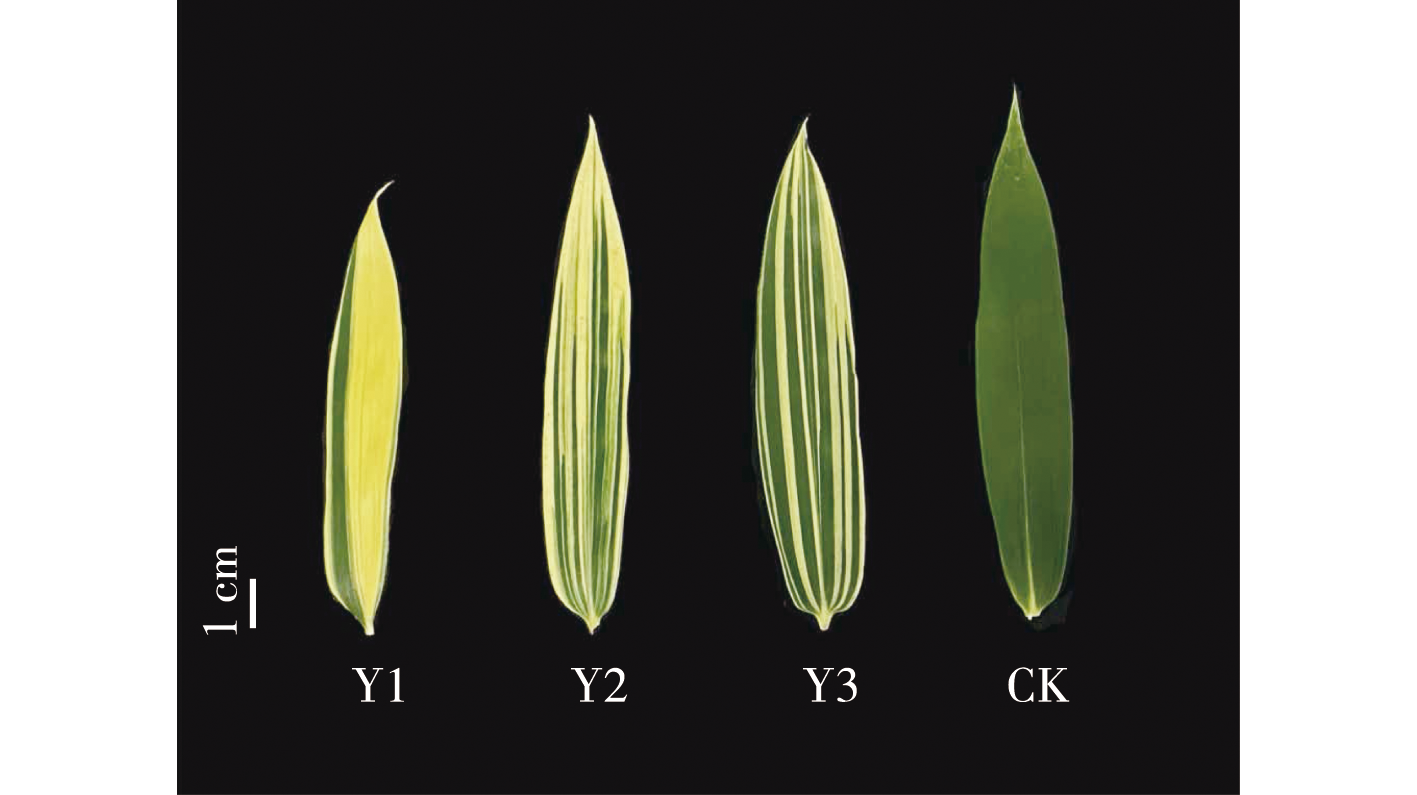 PDF(50254 KB)
PDF(50254 KB)


The relationship of appearance, structure and photosynthetic characteristics of different leaf color phenotypes of Sasaella glabra ‘Albostriata’
XU Xinlu, KONG Shuxin, LYU Zhuo, JIANG Shuaijun, ZHAO Wanqi, LIN Shuyan
Journal of Nanjing Forestry University (Natural Sciences Edition) ›› 2025, Vol. 49 ›› Issue (1) : 145-154.
 PDF(50254 KB)
PDF(50254 KB)
 PDF(50254 KB)
PDF(50254 KB)
The relationship of appearance, structure and photosynthetic characteristics of different leaf color phenotypes of Sasaella glabra ‘Albostriata’
【Objective】We have used Sasaella glabra as a model to investigate the relationship between various leaf color phenotypes of S. glabra ‘Albostriata’ and their photosynthetic capabilities.【Method】Four different leaf color phenotypes were selected for the study. Image J software was used to measure the length, breadth, and surface area of the leaves. The dry weight of the leaves was determined using an electronic balance. Leaf color parameters were assessed using the color picker feature in Adobe Photoshop CC 2018. Photosynthetic pigment levels were measured using visible light spectrophotometry. Diurnal variations in photosynthesis and light response curves were recorded with the Li-6400 portable photosynthesis measurement system. Chlorophyll fluorescence parameters were measured using the CF Imager program. The relationships between leaf color parameters and photosynthetic pigments, as well as between photosynthetic pigments and the net photosynthetic rate, were analyzed. Chlorophyll and chlorophyll fluorescence parameters were also examined. The fluorescence microstructure and ultrastructure of leaves were observed according to leaf color division. 【Result】The biological characteristics of leaves with different color phenotypes varied significantly. For instance, S. glabra exhibited significantly higher leaf length, width, area, and dry weight compared to S. glabra ‘Albostriata’, with these indices increasing as the green stripe area expanded. Similarly, the leaf color parameters of different phenotypes were significantly different. The absolute value of the a* value, indicating red-green coloration, increased, while the trends of the L* value (brightness), b* value (yellow-green coloration), and C* value (chroma) all decreased synchronously. The microstructures of various leaf types showed no significant differences in cell organization. The primary distinction was that in S. glabra and the green area of S. glabra ‘Albostriata’, mesophyll cells differentiate into arm cells and rosette cells, respectively, with chloroplasts occupying the mesophyll cells. In contrast, mesophyll cells in the yellow area of S. glabra ‘Albostriata’ showed notable differences, such as thicker cell walls, larger cell cavities and more degradation products. The mesophyll cell shape and differentiation in the green area resembled those of S. glabra, except for the presence of osmiophilic granules. The four genotypes exhibited significant differences in chlorophyll a, b, total chlorophyll, and carotenoids levels. The S. glabra had the highest concentration of photosynthetic pigments. The amount of photosynthetic pigments increased with the stripe area, showing a significant positive correlation with the a* value and a significant negative correlation with the L*, b*, and C* values. The leaf color genotypes also differed in light response curves and diurnal photosynthesis fluctuations. Chlorophyll content was positively correlated with the net photosynthetic rate, stomatal conductance, and transpiration rate, and was directly proportional to F0. The only significant variation in chlorophyll fluorescence parameters was F0, indicating normal PS Ⅱ photoreaction center activity. 【Conclusion】 The three distinct leaf color phenotypes of S. glabra ‘Albostriata’ differ significantly in appearance, structure, and photosynthetic properties. The leaf color directly reflects these differences, illustrating that the number and development of chloroplasts affect chlorophyll content. Chlorophyll content is positively related to photosynthetic capacity. Morphological indicators such as leaf area and dry matter content can indicate the content of photosynthetic products, though the complex regulatory mechanisms behind this relationship warrant further investigation.

Sasaella glabra ‘Albostriata’ / chlorophyll / chloroplast / leaf color parameter / photosynthetic characteristic
| [1] |
|
| [2] |
|
| [3] |
|
| [4] |
王啸晨, 张磊, 岳祥华, 等. 菲黄竹叶片色素含量、结构与颜色之间关系初探[J]. 世界竹藤通讯, 2012, 10(6):5-9.
|
| [5] |
成敏敏, 陈柯伊, 朱雪玉, 等. 花叶矢竹复绿期光合特性及叶绿体结构[J]. 林业科学, 2018, 54(4):1-10.
|
| [6] |
赖金莉, 李欣欣, 陈凌艳, 等. 银丝竹3种颜色叶片光合特性研究[J]. 生态环境学报, 2018, 27(2):255-261.
|
| [7] |
陈凌艳, 谢德金, 荣俊冬, 等. 光合色素含量差异对花叶唐竹不同叶色表型光合特性的影响[J]. 林业科学, 2019, 55(12):21-31.
|
| [8] |
苏佳露, 史无双, 杨雅运, 等. 6个竹种叶色与光合色素含量及叶片结构比较[J]. 林业科学, 2020, 56(7):194-203.
|
| [9] |
李正理. 植物制片技术[M]. 2版. 北京: 科学出版社, 1987.
|
| [10] |
|
| [11] |
|
| [12] |
王改萍, 张磊, 姚雪冰, 等. 金叶银杏叶色变化特性分析[J]. 南京林业大学学报(自然科学版), 2020, 44(5):41-48.
|
| [13] |
崔祺, 吴昀, 李东泽, 等. 彩叶桂叶片发育过程中叶色表型与色素成分变化[J]. 南京林业大学学报(自然科学版), 2023, 47(2):79-86.
|
| [14] |
冯乃杰, 郑殿峰, 赵玖香, 等. 植物生长物质对大豆叶片形态解剖结构及光合特性的影响[J]. 作物学报, 2009, 35(9):1691-1697.
|
| [15] |
苏佳露, 林树燕, 史无双, 等. 6个竹种竹叶的解剖形态观察与三维构建[J]. 南京林业大学学报(自然科学版), 2020, 44(1):47-53.
|
| [16] |
|
| [17] |
杜成凤, 李潮海, 刘天学, 等. 遮荫对两个基因型玉米叶片解剖结构及光合特性的影响[J]. 生态学报, 2011, 31(21):6633-6640.
|
| [18] |
吴志庄, 高贵宾, 欧建德, 等. 生物炭肥对毛竹林下三叶青叶绿素含量、光合与荧光特性的影响[J]. 西北林学院学报, 2017, 32(5):59-63,103.
|
| [19] |
|
| [20] |
|
| [21] |
|
| [22] |
陈柯伊, 李朝娜, 成敏敏, 等. 不同叶色矢竹叶绿体结构和光系统特性差异[J]. 植物学报, 2018, 53(4):509-518.
|
| [23] |
陈建明, 俞晓平, 程家安. 叶绿素荧光动力学及其在植物抗逆生理研究中的应用[J]. 浙江农业学报, 2006, 18(1):51-55.
|
| [24] |
张其生. 3个马拉巴栗叶色突变体色素含量与光合特性分析[J]. 闽南师范大学学报(自然科学版), 2022, 35(3):97-104.
|
| [25] |
|
| [26] |
|
| [27] |
李娟霞, 田青. 兰州市6种园林植物叶片形态和光合生理特征[J]. 西北农林科技大学学报(自然科学版), 2022, 50(1):72-80.
|
| [28] |
陶汉之, 李展, 孟彩萍, 等. 对生玉米叶面积分布、蒸腾速率和水分利用率的研究[J]. 作物学报, 2000, 26(1):65-70.
|
/
| 〈 |
|
〉 |